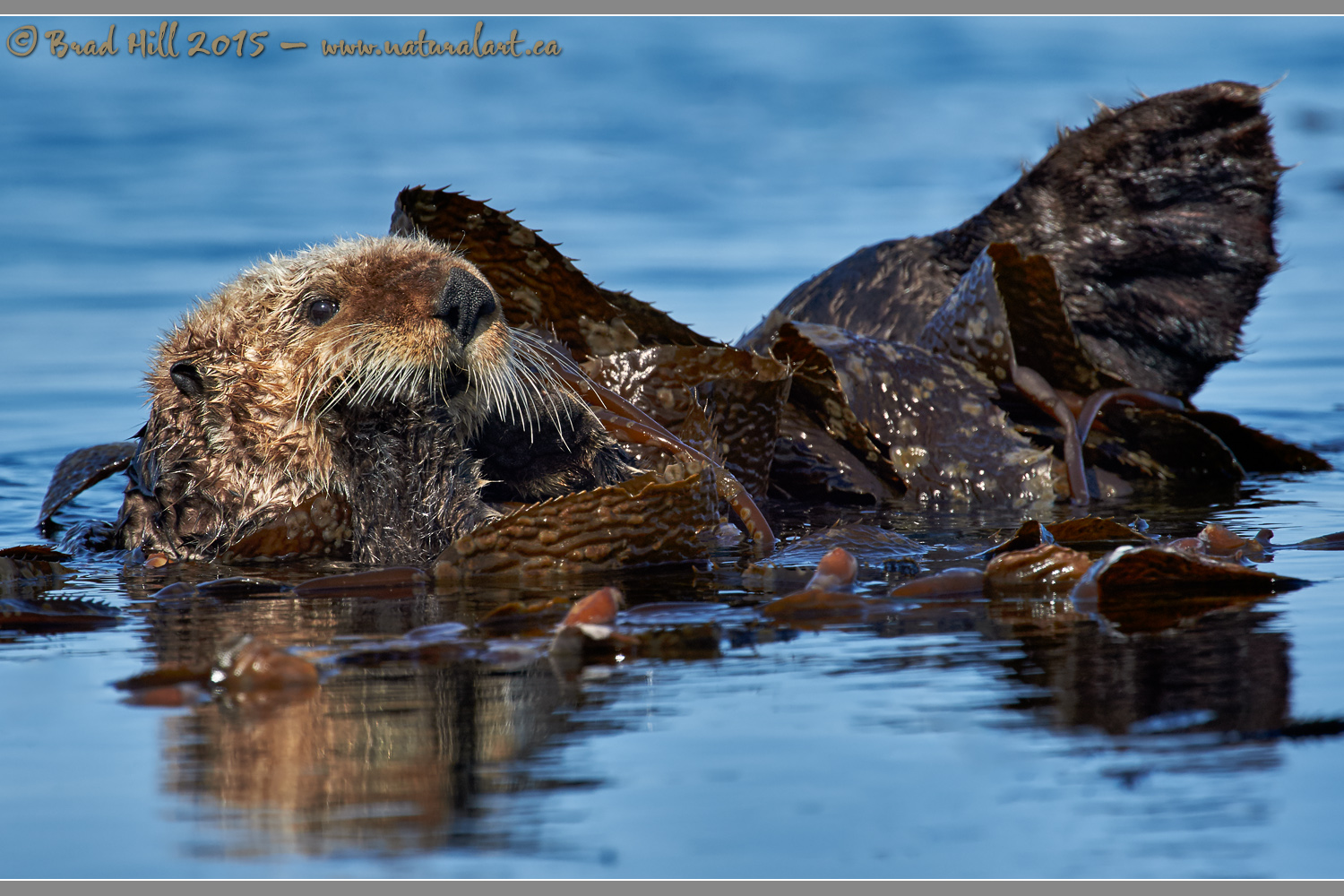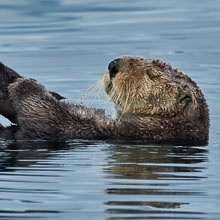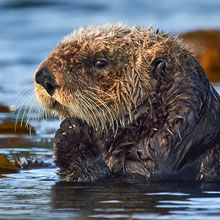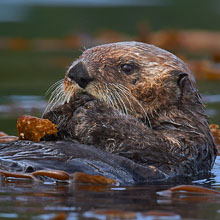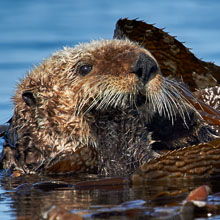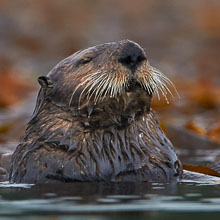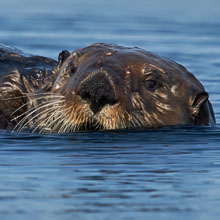Availability: Undetermined - Enquiries?
In the Field
That's a Wrap! Northern Vancouver Island, Canada, BC, Canada. August 13, 2015.
Few cross-kingdom relationships in nature are as intertwined as that between the Sea Otter (Kingdom Animalia) and Bull Kelp (Kingdom Chromalveolata). The two species have an extremely tight ecological relationship - the predation of shellfish (particularly sea urchins) by the otters allows the kelp to escape being over-harvested by the shellfish and, ultimately allows the kelp to prosper and form thick underwater forests. The otters, in turn, directly use (and are almost dependent upon) the kelp for a variety of reasons, including using them in an ingenious way to anchor themselves from drifting away when they decide to grab 40 winks! Here we were watching this male sea otter as he became increasingly drowsy. Just before nodding off, he swam over to a nearby thick kelp bed, grabbed onto the leafy blades, and rolled over and over in the water until he was fully wrapped up (and anchored in place)! Shortly after this shot was taken the otter fell into a peaceful slumber...with the knowledge he'd wake up in the same place he fell asleep!
I captured this image using my favourite lens for wildlife photography - a Nikkor AF-S 400mm f2.8E VR prime lens. In this case, I had it paired up with a 2x teleconverter (the TC-20EIII), functionally converting it to an 800mm f5.6 lens. My view towards teleconverters (TC's) has evolved somewhat over time. In general, the overall optical performance of Nikon's newest TC's - when paired up with many new lenses (including selected zoom lenses like the 70-200mm f4 VR and the AF-S 80-400mm f4.5-5.6 VR) - now far surpasses the performance of older teleconverters. Personally I'm still quite reluctant to use TC's with zoom lenses, but find that with selected prime lenses they can produce top-notch images.
Two of Nikon's best lenses for pairing with teleconverters - both from an optical perspective and from a "usability in the field" perspective (after factoring in the reduction in maximum aperture associated with the use of the TC's) - are the AF-S 300mm f2.8 VRII and the AF-S 400mm f2.8E VR. In my own photography I'm finding myself turning to both the 1.4x (TC-14EIII) and the 2x (TC-20EIII) teleconverters quite regularly - and I'm almost never disappointed with the results. And, I've been noticing more and more Nikon-shooting participants showing up on my photo tours with teleconverters in their kits. Given the increasingly tight and restrictive regulations we're all facing with our luggage (and especially carry-on luggage) when we fly, leaving the super-big lenses at home and bringing shorter lenses plus teleconverters along makes a whole lot of sense. Thankfully they've improved to the point where using them represents far less of a compromise than it did in the past. Here's hoping Nikon chooses to update their 1.7x TC to match the standards of the new versions of the 1.4x and 2x TC's real soon...
For those who might want to do a little pixel-peeping on this shot - here's a 2400-pixel version:
• That's a Wrap! Download 2400 pixel image (JPEG: 1.4 MB)
ADDITIONAL NOTES:
1. This image - in all resolutions - is protected by copyright. I'm fine with personal uses of it (including use as desktop backgrounds or screensavers on your own computer), but unauthorized commercial use of the image is prohibited by law. Thanks in advance for respecting my copyright!
2. Like all wildlife photographs on this website, this image was captured following the strict ethical guidelines described in The Wildlife FIRST! Principles of Photographer Conduct. I encourage all wildlife photographers to always put the welfare of their subjects above the value of their photographs.
3. This image was captured during my "Humpback, Orcas, Sea Lions & More" photo tour in August of 2015. Each year I offer trips into two different parts of the Great Bear Rainforest as well as one to photograph aquatic mammals and oceanscapes near the northern tip of Vancouver Island. And, in selected years, I also offer photo tours to locations to capture other highly sought-after subjects, such as various owl species of the boreal forest and wildlife of Canada's Arctic. Details about these trips can be found on the Photo Tours page of this website.
Behind the Camera
That's a Wrap! Northern Vancouver Island, Canada, BC, Canada. August 13, 2015.
Digital Capture; Compressed RAW (NEF) 14-bit format; ISO 1100.
Nikon D4s paired with Nikkor 400mm f2.8E VR plus TC-20EIII (2x) teleconverter (800mm total focal length). Hand-held from floating Zodiac, VR on and in "Sport" mode.
1/1250s @ f11; no compensation from "recommended" matrix-metered exposure setting
At the Computer
That's a Wrap! Northern Vancouver Island, Canada, BC, Canada. August 13, 2015.
RAW Conversion to 16-bit TIFF using Phase One's Capture One Pro 8. Three raw variants (different versions of a single raw capture) processed, with the variants differing in exposure (0.5 stop total difference between the variants) AND highlight recovery settings.
Further digital corrections on resulting 16-bit TIFF files using Adobe's Photoshop CC 2015 and Light Crafts Lightzone. Photoshop adjustments included compositing (blending) of the three output files from the raw converter, minor selective exposure adjustments, minor selective colour saturation and desaturation, minor selective contrast adjustments, and selective sharpening for web output. Final tone-tweaking performed using LightZone's "tonemapper" tool.
Conservation
That's a Wrap! Northern Vancouver Island, Canada, BC, Canada. August 13, 2015.
Ten percent of the revenue generated by this image will be donated to Raincoast*.
Species Status in Canada**: Special Concern (April 2007) - protected off the North American coast since 1911.
Back in the late 1800's and early 1900's the Sea Otter (Enhydra lutris) was hunted to near extinction along both the Asian and North American Pacific Coasts. The reason? It's luxuriant coat. Otters are unlike any other aquatic mammal in that they don't use fat or blubber to insulate themselves from the chilling effects of the water they are found in. Instead, they rely on their amazingly thick fur coat for insulation. Their amazing coats have a higher density of hair (up to 150,000 strands of hair per square cm!) than any other animal in existence today. To ensure that this coat serves its insulative purpose, otters spend a disproportionately large amount of time grooming their coat (to ensure its natural oils continue to provide an effective waterproof barrier). Unfortunately, the biological functioning of the otters coat can be easily fouled by contamination by oil and other hydrocarbons - thus making them extremely sensitive to the effective of marine oil spills.
Other fascinating aspects of the biology and behaviour of the sea otter include the use of tools (they will use rocks to break apart shellfish such as sea urchins), and the fact that they have an metabolic rate two to three times higher than other mammals of their size. This means they must eat 23% to 33% of their own body weight DAILY, just to to replace the calories burned through maintaining their body temperature in the cold water environment they live in.
*The Raincoast Conservation Society (and Foundation) is an effective and efficient organization that has been fighting for protection of this unique habitat. If you are looking for a meaningful way to contribute to the conservation of this amazing ecosystem, Raincoast will provide maximal "bang" for your conservation dollars.
**as determined by COSEWIC: The Committee on the Status of Endangered Wildlife in Canada












